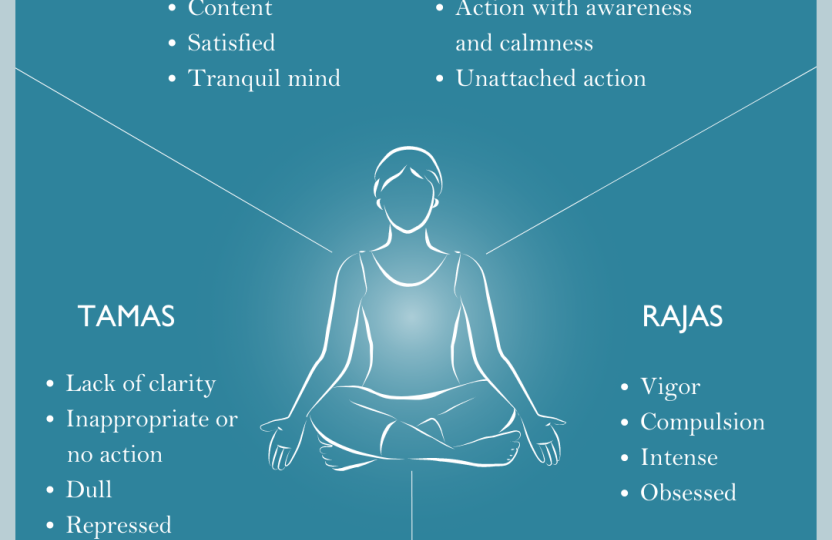
Maha Gunas: The Light of Awareness
Share

In the vast, interconnected traditions of Ayurveda and Yoga, an essential concept known as 'gunas' offers profound insights into the nature of existence and the human psyche. Literally translating to 'qualities', 'gunas' refer to the three fundamental attributes that, in balance or imbalance, shape our thoughts, actions, and the very fabric of our reality. For practitioners of yoga and holistic health alike, understanding and harnessing the gunas can be a key to unlocking the deeper layers of self-awareness and healing. This blog post is a deep-dive into the Maha Gunas and how incorporating their wisdom into practice can lead to a life of health, joy, and purpose.
The Three Fold of Our Nature
According to the philosophies of Ayurveda and Yoga, our existence is an intricate dance of three primary gunas—Tamas, Rajas, and Sattva. These gunas are universal and omnipresent, found in different combinations and degrees in all aspects of life, including our own self.
Tamas: The Inertia of Being
The quality of Tamas is characterized by heaviness, darkness, and stagnation. It represents the seed potential, the potent state of being that contains within it all possibilities and remains unmanifest. Tamas is the state of the universe before the unfolding of creation, and in our life, it is the inertia that sometimes veils our true nature, keeping us in a state of inactivity or ignorance.
Rajas: The Energetic Intermediary
In contrast, Rajas is the force of energy, action, and change. It is the quality that pushes us to strive, to create, and to experience the world through our senses. Rajas is the life potential that propels us forward, but if unbridled, can lead to restlessness and a sense of unfulfillment.
Sattva: The Luminous State
Finally, Sattva is the quality of harmony, balance, and intelligence. It is when Sattva dominates that we experience clarity of mind, empathy, wisdom, and joy. Sattva reflects our higher or spiritual potential and can be cultivated through practices that promote compassion, truthfulness, and tranquility.
Integration of the Gunas in Traditional Yoga
In traditional yoga, the gunas serve as a roadmap for self-realization and are deeply interwoven with the teacher-student dynamic. A teacher may assess a student's dominant guna to determine their readiness for certain teachings, knowing that only when Sattva predominates can the subtler aspects of yoga be perceived. However, the ultimate goal is not merely the cultivation of Sattva but the transcendence of all gunas as one moves towards enlightenment.
A Journey Through the Gunas
It is believed that the human experience is cyclic, moving through the gunas in a sort of dance of life and death. Think of a seed, initially tamasic as it lies dormant in the soil. With the onset of spring, it becomes infused with the energy of Rajas, sprouting into a plant that finally blooms—a moment of Sattva. Then, as the flower withers and returns to the earth, it regains its tamasic qualities, ready to begin the cycle anew.
Ayurveda and the Gunas: Balancing Life Forces
Ayurveda takes a holistic view of health, understanding that all three gunas are necessary for life and each fulfills a unique purpose. It suggests that the key to wellness is a harmonious interplay of the gunas. When any one quality dominates, it can lead to imbalances and disease. In Ayurvedic practice, treatments are often designed to restore this balance, whether through diet, lifestyle adjustments, or medicinal herbs.
The Modern Applications of Yoga Therapy
Modern applications of yoga and Ayurveda, particularly in the field of yoga therapy, have adapted the wisdom of the gunas to meet the needs of the individual. Here, the gunas are seen as dynamic and can change depending on factors like the season of the year, state of health, or emotional well-being.
Seasonal Practices
During periods of illness or grief, for example, incorporating more Tamas into one's routine can be grounding and healing. Conversely, in times of lethargy or depression, a practice that encourages Rajas can bring about energy and a renewed sense of purpose.
Personalized Therapies
Individuals may be guided to tailor their yoga practice and herbal regimens according to their guna constitution, ensuring that the balance is maintained for optimal health. By recognizing the present combination of gunas at play, one can work towards integrating practices that support their unique needs at any given moment.
Concluding Thoughts on The Path of Yoga and Self-Discovery
The gunas offer a lens through which we can view our experiences and an avenue through which to explore the depths of our being. By integrating the wisdom of the gunas into our yogic and Ayurvedic practices, we can begin to recognize the patterns that bring us joy and those that lead us astray. The key lies not in rejecting any one quality but in acknowledging their interdependence and the transformations they bring. It is through this awareness that we start to unravel the mysteries of our existence and tap into the boundless potential that lies within.
In a world that often champions one extreme over another, the gunas remind us that true well-being is found in the delicate balance. And as we strive to create this equilibrium within ourselves, we not only heal and grow but also begin to understand our place in the grand symphony of life. The Maha Gunas in Ayurveda and Yoga are not just ancient concepts but powerful tools that can guide us on the path to a life that is vibrant, purposeful, and aligned with the very essence of our being.